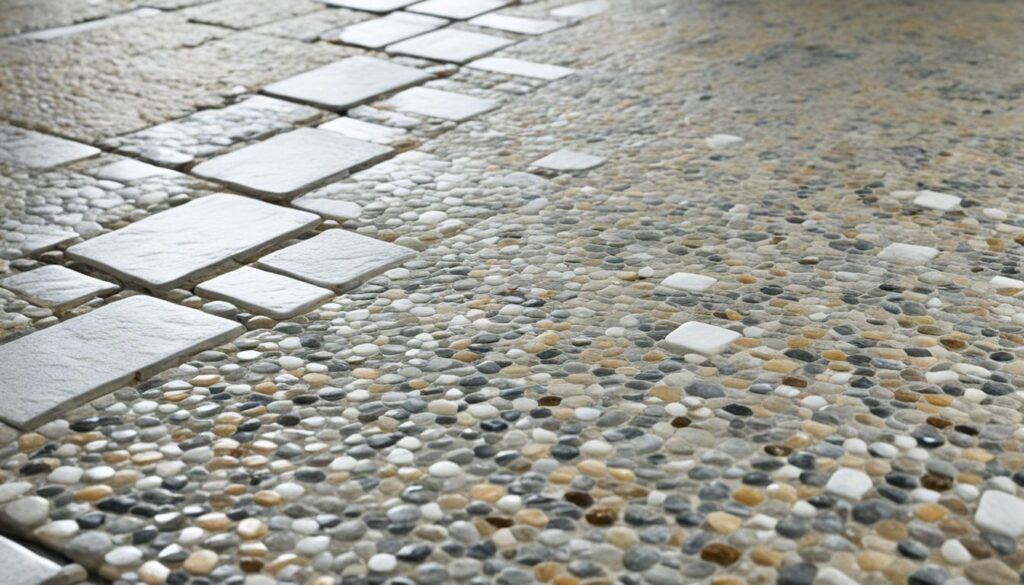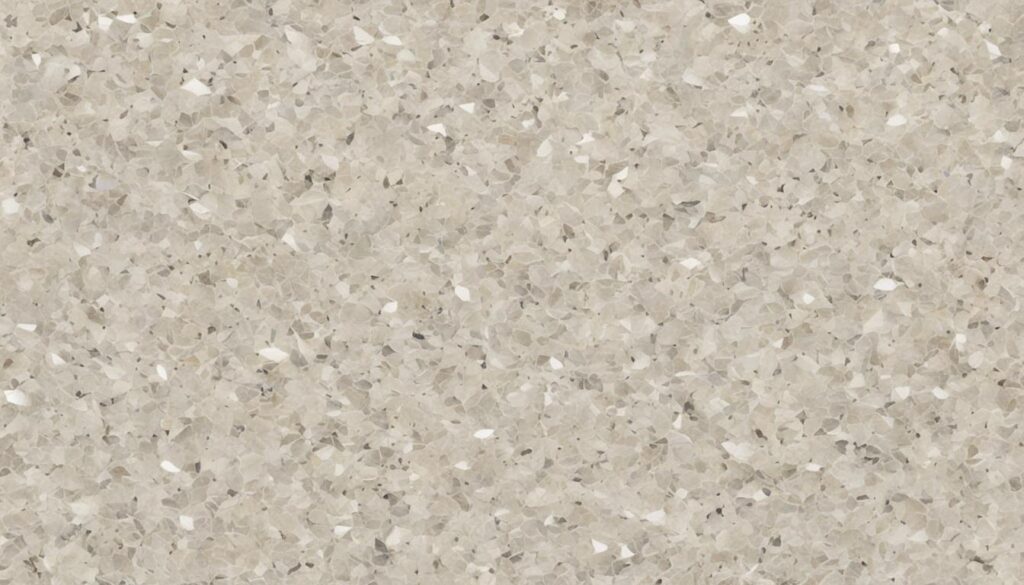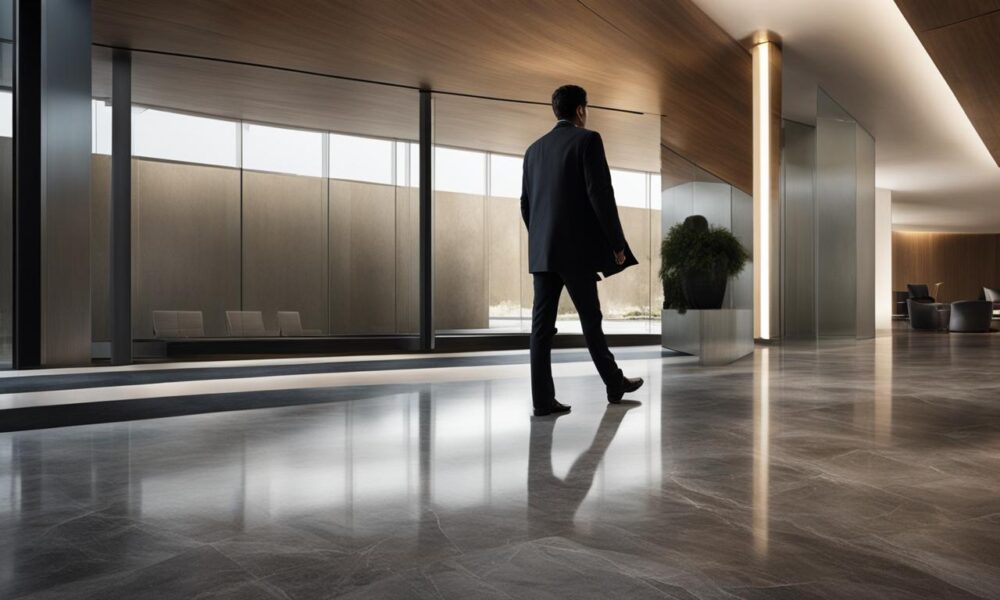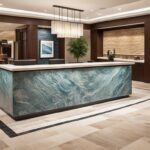Slip-Resistant Natural Stone Flooring Safety
In the realm of floor safety, the application of anti-slip measures is not merely a precaution but a necessity, especially when the elegance of natural stone flooring meets the demands of high-traffic areas. Reflecting a ‘Safety First’ approach, Credit Suisse Bank tackled the issue of slippery natural stone in its prestigious entrance hall with efficacy and urgency. Through the strategic implementation of GriP AntiSlip coating class R11, the bank has successfully converted its once treacherous surface into a bastion of slip resistance.
Prioritizing the well-being of both customers and staff, the bank’s move to reinforce floor safety is a prime example of how preventative slips tactics are being woven into the corporate safety fabric. The transformation was not only rapid, covering an expansive 500 square meters in a single weekend, but also efficient, signifying a landmark stride in stone floor maintenance and care.
Key Takeaways
- Slip resistance in natural stone flooring is critical for preventing accidents in high-traffic areas.
- Quick and effective anti-slip solutions can enhance safety without compromising the floor’s aesthetic value.
- Adopting anti-slip measures is a key component of a comprehensive floor safety strategy.
- Essential stone floor maintenance ensures continued safety and preserves the integrity of the flooring.
- Proactive steps like the application of GriP AntiSlip coating can significantly reduce slip and fall incidents.
- The success seen in high-profile cases sets a precedent for similar safety measures in various industries.
The Transformative Effect of Anti-Slip Coatings on Natural Stone Flooring
With the integration of anti-slip measures into the architectural fabric of corporate spaces, the focus on slip-resistant flooring has intensified. An exemplary instance of this trend is the sophisticated entrance hall of the Credit Suisse Tower. The natural stone flooring, renowned for its elegance, posed a slip risk which was swiftly addressed using advanced safety solutions.
The Case Study of Credit Suisse Tower’s Entrance Hall
The challenge was twofold: maintaining the lobby’s luxurious natural stone aesthetic while meeting safety standards for slip resistance. In response, over a single weekend, the vast expanse of 500 square meters was treated with an efficient application of GriP AntiSlip coating, sourced from a respected specialist in floor sealing. This proactive measure ensured that come Monday, employees and clients were greeted with not only stunning but also safer flooring.
Understanding Anti-Slip Coating Classifications
At the heart of this safety initiative lies the R11 classification of the anti-slip coating applied—a hallmark of anti-slip measures meticulously tested to offer firm footing. The distinction of R11 is no minor feat; it implies rigorous adherence to safety standards, guaranteeing slip resistance across angles of 19° to 27°. Hence, the transformed entrance hall not only met but surpassed the expected benchmarks for slip-resistant flooring, setting a precedence in safety without sacrificing style.
Composite Parameters Guiding Stone Flooring Slip Resistance
When it comes to ensuring safety standards for flooring, especially in sectors where visual appeal must match functional resilience, slip-resistant flooring stands at the forefront of design considerations. One cannot underestimate the value of precise criteria that guide the slip resistance of natural stone flooring. These criteria are not arbitrary but are the result of comprehensive testing and standardization, aimed at safeguarding patrons in commercial and public settings.
Within this framework, anti-slip measures such as the R11 anti-slip criterion have become pivotal in certifying the safety of flooring installations. Let’s delve deeper into the guidelines that set the R11 anti-slip classification apart and explore the groundbreaking research that has paved the way for enduring floor safety.

Establishing R11 Anti-Slip Criteria
The R11 classification is not just a mere label—it represents a significant angle of inclination where the anti-slip property has been thoroughly tested and proven. These performance-based safety standards are unique in that they cater to environments where the potential for slips is augmented due to heavy foot traffic or the presence of moisture. Facilitating safe mobility, the R11 criterion has become synonymous with trust when it comes to selecting natural stone flooring for areas requiring stringent anti-slip measures.
Innovative Research by McDonalds on Sustainable Slip Resistance
In their quest to marry functionality with assurance, McDonald’s Restaurants spearheaded innovative research to assess the lasting effectiveness of wet slip resistance under simulated real-world conditions. This Sustainable Slip Resistance (SSR) study evaluated flooring after enduring the onslaught of foot traffic, ensuring that slip-resistant flooring properties persist beyond initial installation. Acknowledging the gravity of enduring safety, this scrutiny brings peace of mind that a surface will continue to protect against slips, reinforcing the paramount importance of enduring safety solutions in flooring design.
The Synergy of Aesthetics and Safety in Natural Stone Flooring
The pursuit of combining aesthetics with safety first practices in the realm of flooring design has resulted in groundbreaking synergies that are reshaping the industry. At the forefront of this movement is Miller Druck Specialty Contracting, alongside Sotter Engineering’s Safety Direct America, who have meticulously tested a series of natural stone flooring samples to ensure that high safety standards do not forego the elegance inherent to natural stone. With advancements in anti-slip measures, it is now possible to enjoy the luxurious appearance of natural stone while ensuring the well-being of those who tread upon it.

Miller Druck’s commitment to the harmony of safety and aesthetics was put to the test with an extensive study of 35 natural stone samples, using iterative trials with a soft TRL rubber slider—a method that closely replicates the contact dynamics of shoe soles. This robust approach culminated in identifying 26 out of the 35 samples that exhibited Sustainable Slip Resistance (SSR), effectively marrying tactile safety with visual splendor.
This sophisticated approach does more than just meet the eye; it meets rigorous criteria for safety. Specifically, in areas typically bustling with activity, such as restaurant customer zones, a wet Pendulum Test Value (PTV) of at least 35 serves as the threshold for SSR certification. Such a standard is crucial, denoting a flooring’s ability to provide a secure footing even under the most challenging conditions.
According to detailed research, these anti-slip measures transcend mere compliance with safety requirements; they define a new level of due diligence in property management, particularly when it comes to flooring exposed to the elements or areas predisposed to water exposure. A deeper look into these samples reveals PTV ratings scaling up to the demands of high-risk areas like outdoor ramps or poolside zones, showcasing a spectrum of slip resistance that satisfies varied environmental challenges.
| Natural Stone Finish | Wet PTV Score After Abrasion | Applicability |
|---|---|---|
| Miller Druck’s Flamed Finish | 63 | Outdoor Ramps & Pool Areas |
| Standard Sand-Sprayed Finish | 35+ | Restaurant Customer Zones |
| Textured Stone Finish | 40 | High Foot Traffic Areas |
| Polished Stone (with SSR) | 50 | Lobby & Entrance Halls |
The practical applications of SSR are as diverse as the natural stone options available. Whether selecting a finish robust enough for an outdoor terrace or subtle enough for an upscale lobby, the choice no longer stands between safety and beauty—it’s a matter of selecting the right SSR-rated flooring. This shift not only represents a critical evolution in flooring functionality but also demonstrates how spaces can be crafted with a proactive approach to preventing accidents, all while enclosing occupants within an aesthetically magnificent environment.
Stone Flooring Techniques That Guarantee Safety Standards
Implementing safety first principles in architectural design goes beyond mere compliance; it’s a commitment to protect and enhance the user experience. Miller Druck has become a paragon in this domain, setting the benchmark for stone flooring techniques that align with rigorous safety standards. Their foray into developing industry-leading SSR (Sustainable Slip Resistance) stone flooring speaks to their dedication to merge visual appeal with unmatched safety performance.
Miller Druck’s Industry-Leading SSR Stone Flooring
Encapsulating both safety and elegance, Miller Druck’s stone flooring sets a new paradigm in the flooring industry. By adopting and perfecting stone finishing techniques, their catalogue boasts the feat of having the largest collection of stone with verified SSR, offering a potent testament to their technological and aesthetic prowess. It’s a nuanced approach that emphasizes the safety of end-users without overlooking the intrinsic beauty of natural stone.
Techniques Proven to Yield High Slip-Resistance
With a keen eye on detail and functioning, Miller Druck’s flamed finish technique stands out among its accomplishments, achieving Sustainable Slip Resistance in a striking 95% of their tested samples. Their relentless pursuit for perfection also extends to sand-sprayed stone finishes, which have consistently demonstrated high SSR across various tests. Miller Druck’s dedication ensures that safety is never second to sophistication, providing bespoke solutions that cater to both the aesthetic and functional demands of high-end properties and large-scale public works.



